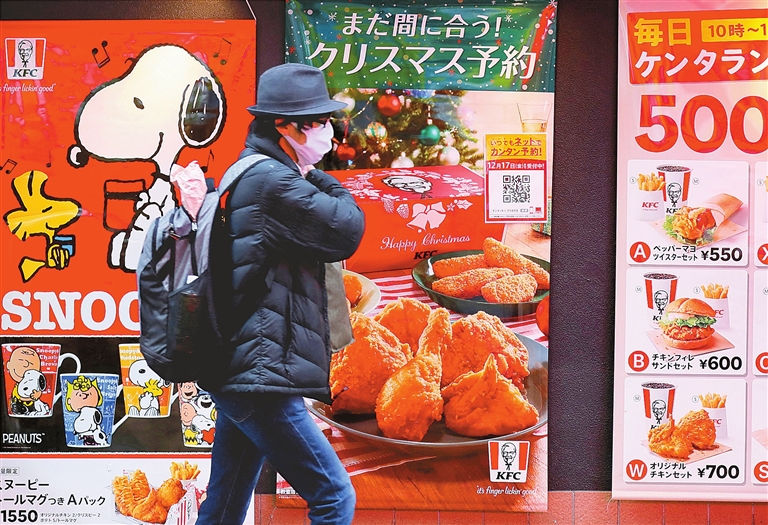
ALMOST every year since she was a child, Hokkaido resident Naomi has looked forward to her family’s traditional Christmas meal: a KFC “party barrel” brimming with salad, cake and lots of fried chicken. “In Japan, it is customary to eat chicken at Christmas,” says the 30-something Japanese woman. Naomi, who asked only to be identified by her first name, and her family are far from being the only Japanese residents who enjoy KFC for Christmas dinner. Every year since the mid-1980s, life-size Colonel Sanders statues — dressed as Santa during the holiday — have welcomed droves of locals and tourists alike across the country. According to figures released by the American fast-food chain, KFC Japan pulled in 6.9 billion yen (roughly US$63 million) from Dec. 20 to 25 in 2018, with lines out the door starting on Dec. 23. KFC Japan’s busiest day is usually Dec. 24, on which they usually sell about five to 10 times more than typical days. “As Christmas approaches, KFC commercials play on TV. We order early and go to the store at the designated time to pick up our bucket,” says Naomi. “Those who don’t reserve a bucket see themselves in long queues for hours.” During a period of rapid globalization, Japan’s fast-food industry expanded 600% between 1970 and 1980, according to “Colonel Comes to Japan,” a 1981 documentary directed by John Nathan. KFC — then known as Kentucky Fried Chicken — was part of the pack, opening its first Japan outlet in Nagoya in 1970. By 1981, the chain had opened 324 stores — over 30 a year — and made roughly US$200 million per year, according to the documentary. Christmas was, and still is, a secular holiday in Japan — a country where less than 1% of the population identifies as Christian — and in the 1970s many people didn’t have established family Christmas traditions. That’s where KFC came in. The company launched its “Kentucky for Christmas” marketing campaign in 1974 and the first iteration of the party buckets soon followed. Some reports say that Takeshi Okawara, who managed the country’s first KFC and later became CEO of KFC Japan, falsely marketed fried chicken as a traditional American Christmas food to drum up sales. But according to KFC Japan, Okawara went to a Christmas party dressed as Santa. When the kids loved it, he saw a business opportunity. In 2020, the global KFC website published its own explainer, noting that the original idea for the campaign came when a foreign customer who visited KFC in Tokyo on Christmas said, “I can’t get turkey in Japan, so I have no choice but to celebrate Christmas with Kentucky Fried Chicken.” The report says a team member on the brand’s Japan sales team overheard the remark and used it as inspiration to launch the first Christmas campaign. Meanwhile, in 2017 the host of “The Rising Sun Show” — a 30-minute TV show produced by the U.S. Army Garrison Japan Public Affairs — interviewed a KFC meister, who said the concept caught on after a foreign customer asked KFC to deliver fried chicken in a Santa Claus costume on Christmas. Conflicting origin stories aside, KFC managed to capture the imagination of Japanese diners and create a national phenomenon. Of course, “Kentucky for Christmas” didn’t catch on without a substantial advertising investment. A typical KFC Christmas ad from the 1970s or ’80s likely would have showcased a family enjoying a luscious feast of golden, fried chicken as the song “My Old Kentucky Home” played in the background. Despite the song “My Old Kentucky Home” not being a Christmas carol, those were really beautifully done campaigns that linked fried chicken with Christmas. Obviously, the idea took hold. But to chalk up such lasting success solely to smart advertising wouldn’t be totally fair — it can also be attributed to KFC’s compatibility with existing cultural norms. For instance, KFC is similar to a popular traditional Japanese dish called karaage, which comprises small pieces of panko-breaded, deep-fried meats like chicken or fish. Likewise, the tradition of sharing a big “party barrel” of fried chicken, coleslaw and cake fits neatly into Japanese dining culture. (SD-Agencies) | 
